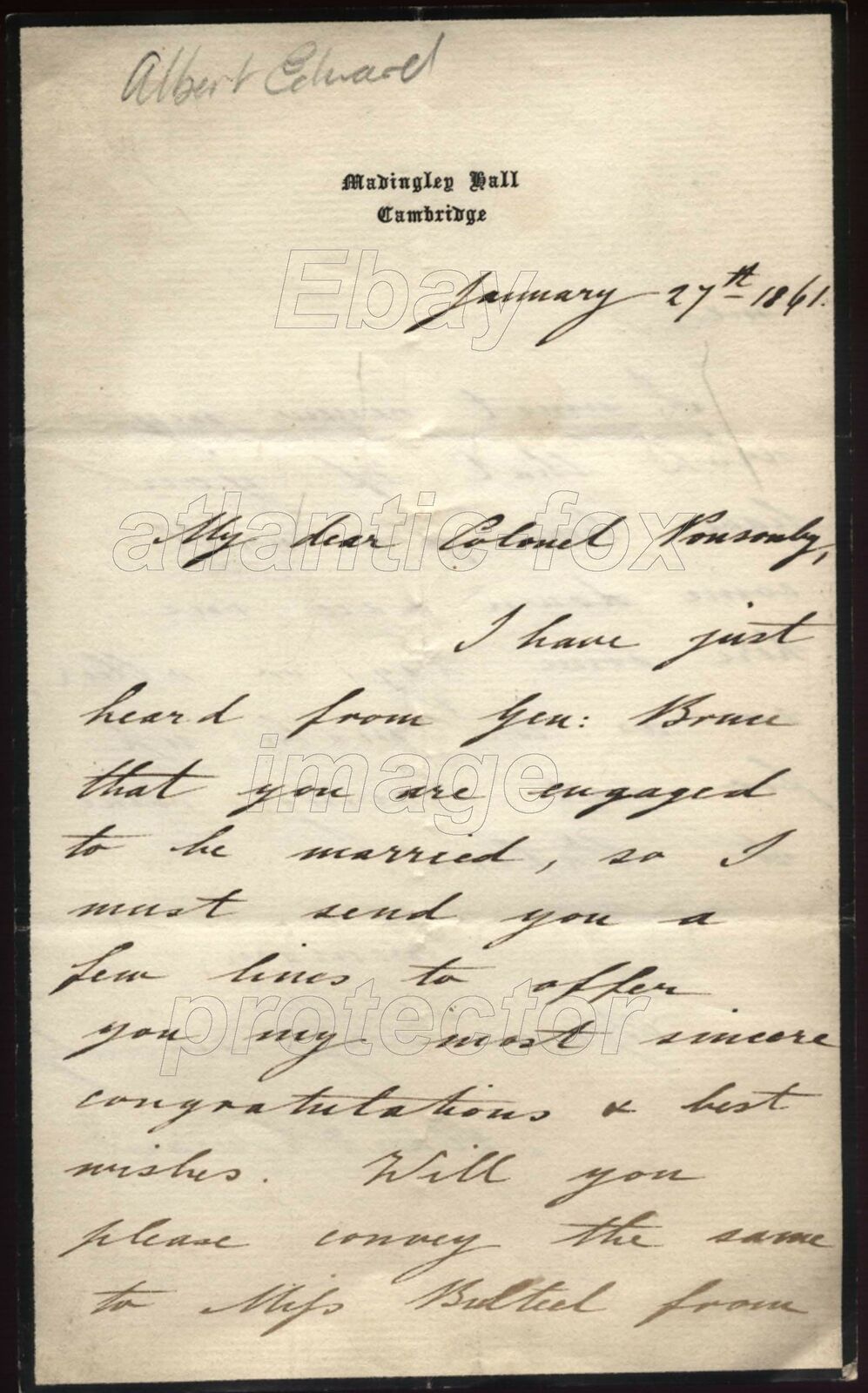-40%
1861 Madingley Hall, Albert Edward Prince of Wales to Col Henry Ponsonby
$ 415.88
- Description
- Size Guide
Description
1861 Madingley Hall, Albert Edward Prince of Wales to Col Henry PonsonbyThis product data sheet is originally written in English.
1861 Madingley Hall,Cambridge, A rare letter from Albert Edward Prince of Wales during his short stay at his residence of Madingley Hall to Col Henry Ponsonby ( Equerry to Albert, Prince Consort & Later Queen Victoria's Private Secretary) congratulating him on his engagement to Mary Bulteel, The Queens Maid of Honour.
He began building Madingley Hall in the same year, creating what are now known as the south and east wings. The south wing contained domestic buildings, the kitchen and a garderobe; the east wing had just a few sleeping rooms, along with two large halls.
The upper hall had a splendid viewing platform, leading to speculation that the Hall was originally conceived as an extravagant hunting lodge, built to flaunt the wealth of the newly-rich Hynde.
When the Hall passed to his son, Sir Francis Hynde, in 1550, he made it the family home, and added the north wing in 1591.
Sir John Hynde Cotton inherited Madingley Hall in 1712: during the 40 years that he owned the Hall he transformed it from a panelled Tudor house into a Baroque building, and closed the medieval village street, with the aim of removing the villagers’ houses from sight.
In January 1861 Edward, Prince of Wales, arrived at Madingley. His mother, Queen Victoria had rented the Hall as a residence for her son whilst he studied at the University. However, his stay was brief and his departure sudden, due to “the great calamity at Windsor” - Prince Albert’s unexpected death.
In 1871 the Hall was sold out of the family to a Mr Hurrell, and subsequently to Colonel Walter Harding in 1905.
Today, the Hall is also home to the University’s Institute of Continuing Education, which provides residential and non-residential courses, conferences and summer programmes for professional groups and the general public from around the world.
Fresh to the Market Place, from Major-General Sir John Ponsonby's Collection
For more from this collection see our shop category for SIR HENRY & JOHN PONSONBY COLLECTION
John Ponsonby (British Army officer)From Wikipedia, the free encyclopedia
Major-General Sir John Ponsonby KCB CMG DSO (25 March 1866 – 26 March 1952) was a British Army officer who commanded 5th Division during World War I
Born the son of Sir Henry Ponsonby (Queen Victoria's Private Secretary), his Mother Hon. Mary Elizabeth Ponsonby, Maid of Honour to Queen Victoria and a daughter of John Crocker Bulteel.
His brothers were Frederick Ponsonby, ( Assistant Private Secretary to Edward VII & GV), and Arthur Augustus William Harry Ponsonby, 1st Baron Ponsonby of Shulbrede, (British politician, writer, and social activist)
:
Powered by SixBit's eCommerce Solution
1861 Madingley Hall,Cambridge, A rare letter from Albert Edward Prince of Wales during his short stay at his residence of Madingley Hall to Col Henry Ponsonby ( Equerry to Albert, Prince Consort & Later Queen Victoria's Private Secretary) congratulating him on his engagement to Mary Bulteel, The Queens Maid of Honour. He began building Madingley Hall in the same year, creating what are now known as the south and east wings. The south wing contained domestic buildings, the kitchen and a garderobe; the east wing had just a few sleeping rooms, along with two large halls.The upper hall had a splendid viewing platform, leading to speculation that the Hall was originally conceived as an extravagant hunting lodge, built to flaunt the wealth of the newly-rich Hynde.When the Hall passed to his son
City/Town/Village/Place
Cambridge
Related Interests
Engagement to Mary Bulteel
EAN
Does Not apply
Royal Residence
Madingley Hall
Royal/ Reign
Victoria (1837-1901)
Royal
Prince Albert Edward, Prince of Wales
England County
Cambridgeshire
To Commemorate
engagement
Royalty
UK Royalty
Era
1861-1870
Addressed to
Colonel Henry Ponsonby
Year
1861
Letter From
Albert Edward
Document Type
Original Manuscript Letter










